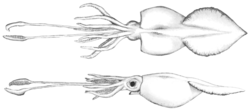
Back سبيدج ضخم Arabic سبيدج ضخم ARZ Колосален калмар Bulgarian Calamar colossal Catalan Mesonychoteuthis hamiltoni CEB Kalmar Hamiltonův Czech Kolosblæksprutte Danish Koloss-Kalmar German Κολοσσιαίο καλαμάρι Greek Kolosa kalmaro Esperanto
| Colossal squid | |
|---|---|

| |
| Depiction with an inflated mantle and reversed tentacles | |
| Scientific classification | |
| Kingdom: | Animalia |
| Phylum: | Mollusca |
| Class: | Cephalopoda |
| Order: | Oegopsida |
| Superfamily: | Cranchioidea |
| Family: | Cranchiidae |
| Subfamily: | Taoniinae |
| Genus: | Mesonychoteuthis Robson, 1925 |
| Species: | M. hamiltoni
|
| Binomial name | |
| Mesonychoteuthis hamiltoni | |

| |
| Global range of M. hamiltoni | |
The colossal squid (Mesonychoteuthis hamiltoni) is a species of very large squid belonging to the family Cranchiidae, that of the cockatoo squids or glass squids. It is sometimes called the Antarctic cranch squid or giant squid (not to be confused with the giant squid in genus Architeuthis) and is believed to be the largest squid species in terms of mass.[3] It is the only recognized member of the genus Mesonychoteuthis.[4]
The species is confirmed to reach a mass of at least 495 kilograms (1,091 lb), though the largest specimens—known only from beaks found in sperm whale stomachs—may perhaps weigh as much as 600–700 kilograms (1,300–1,500 lb),[5][6] making it the largest extant invertebrate.[3] Maximum total length is ~4.2 metres (14 ft).[7] Larger estimates exist, however these include the feeding tentacles measured on dead specimens as in life the squid’s tentacles are hidden, only released when capturing prey. If tentacles are considered, lengths of 10 metres (33 ft) and 14 metres (46 ft) exist, but the former estimate is more likely.[8][9] The colossal squid has the largest eyes of any known creature ever to exist, with an estimated diameter of 27–30 cm (11–12 in)[10] to 40 cm (16 in) for the largest collected specimen.
The species has similar anatomy to other members of its family, although it is the only member of Cranchiidae to display hooks on its arms, suckers and tentacles.[11][12] It is known to inhabit the circumantarctic Southern Ocean.[3] It is presumed to be an ambush predator, with a diet including various fish, and is likely a key prey item of the sperm whale.[13][14]
- ^ Barratt, I.; Allcock, L. (2014). "Mesonychoteuthis hamiltoni". IUCN Red List of Threatened Species. 2014: e.T163170A980001. doi:10.2305/IUCN.UK.2014-1.RLTS.T163170A980001.en. Retrieved 15 September 2022.
- ^ Bieler R, Bouchet P, Gofas S, Marshall B, Rosenberg G, La Perna R, Neubauer TA, Sartori AF, Schneider S, Vos C, ter Poorten JJ, Taylor J, Dijkstra H, Finn J, Bank R, Neubert E, Moretzsohn F, Faber M, Houart R, Picton B, Garcia-Alvarez O (eds.). "Mesonychoteuthis hamiltoni G. C. Robson, 1925". MolluscaBase. World Register of Marine Species. Retrieved 15 September 2022.
- ^ a b c Cite error: The named reference
reviewwas invoked but never defined (see the help page). - ^ Cite error: The named reference
:2was invoked but never defined (see the help page). - ^ "How big is the colossal squid on display? | Te Papa". tepapa.govt.nz. Retrieved 9 April 2025.
- ^ "The beak of the colossal squid | Te Papa". tepapa.govt.nz. Retrieved 9 April 2025.
- ^ "The arms and tentacles of the colossal squid". tepapa. 25 March 2025.
- ^ Roper, C.F.E. & P. Jereb (2010). Family Cranchiidae. In: P. Jereb & C.F.E. Roper (eds.) Cephalopods of the world. An annotated and illustrated catalogue of species known to date. Volume 2. Myopsid and Oegopsid Squids. FAO Species Catalogue for Fishery Purposes No. 4, Vol. 2. FAO, Rome. pp. 148–178.
- ^ "Colossal Squid". Oceana. Retrieved 12 February 2024.
- ^ "The eyes of the colossal squid". Museum of New Zealand Te Papa Tongarewa, Wellington, NZ. 29 December 2016. Retrieved 15 September 2022.
- ^ Cite error: The named reference
:3was invoked but never defined (see the help page). - ^ Cite error: The named reference
suckershookswas invoked but never defined (see the help page). - ^ Nilsson, Dan-Eric; Warrant, Eric J.; Johnsen, Sönke; Hanlon, Roger; Shashar, Nadav (2012). "A Unique Advantage for Giant Eyes in Giant Squid". Current Biology. 22 (8): 683–688. Bibcode:2012CBio...22..683N. doi:10.1016/j.cub.2012.02.031. PMID 22425154.
- ^ Cite error: The named reference
:10was invoked but never defined (see the help page).
